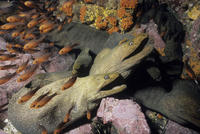You are in: South America -> Colombia -> Malpelo Fauna and Fl... , and traditional search or Image Gallery will yield results of this site only
Malpelo Fauna and Flora Sanctuary
| Site number: | 1216 |
|
| Type of site: | Natural | |
| Date of Inscription: | 2006 | |
| Location: | South America, Colombia, Valle del Cauca Region | |
Up to 75 images are shown here. Click on each for more details or on Image Gallery for more images.
| Description: | The site, found 506 km off the coast of Colombia, comprises of the Malpelo island (350 ha) and the adjacent marine environment (857,150 ha). The vast marine site is the largest no-fishing zone within the Eastern Tropical Pacific. Supplying a critical habitat for internationally threatened marine species, the site is also a key source of nutrients resulting in great clusters of marine biodiversity. Particularly a ‘reservoir' for sharks, giant grouper and billfish, the area is the one of very few confirmed sighting places of the short-nosed ragged-toothed shark (a rare deepwater shark). Due to the presence of steep walls and caves of outstanding natural beauty the site has gained a wide recognition as one of the top diving sites in the world. These deep waters present an environment undisturbed by humans where animals continue to maintain their natural behavioural patterns. The site also sustains important populations of large predators and pelagic species (documented examples encompass: aggregations of over 200 hammerhead sharks and over 1,000 silky sharks, whale sharks and tuna). --WHMNet paraphrase from the description at WHC Site, where additional information is available. | |
| Malpelo Island (Spanish: Isla de Malpelo) is an island located 314 miles off Colombia's Pacific coast at 3°59′N, 81°36′W, 300 km offshore. It has a land area of 0.35 km². It is uninhabited except for a small military post manned by the Colombian Army, which was established in 1986. Visitors need a written permit from the Colombian Ministry of Ecology. The island is part of Cauca Department. The island consists of a sheer and barren rock with three high peaks, the highest being Cerro de la Mona with a height of 300 m. The island is surrounded by a number of offshore rocks. Off the northeast corner are the Tres Mosqueteros. Off the southwest corner are Salomon, Saul, La Gringa, and Escuba. Malpelo Nature Reserve, a plant and wildlife sanctuary, is defined as a circular area of radius 6 miles (9.656 km) centered at 03°58′30″N, 81°34′48″W. Malpelo is home of a unique shark population; swarms of 500 hammerhead sharks and hundreds of silky sharks are frequently seen by diving expeditions, making it a very popular sharkdiving location. Malpelo has been interpreted as a portion of oceanic crust, probably a local manifestation of a "hot spot". It is composed mainly of pillow lavas, volcanic breccias, and Tertiary basaltic dikes. At first glance, the island seems to be barren rock, devoid of all vegetation. But deposits of bird guano have helped colonies of algae, lichens, mosses and some shrubs and ferns establish, all of which glean nutrients from the guano. On July 12, 2006 Malpelo was declared by UNESCO as a natural World Heritage Site. --Wikipedia. Text is available under the Creative Commons Attribution-ShareAlike License. | ||
| Source: | http://whc.unesco.org/en/list/1216 | |
| Reference: | 1. UNESCO World Heritage Center, Site Page. | |













